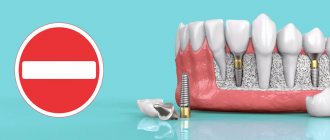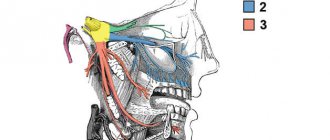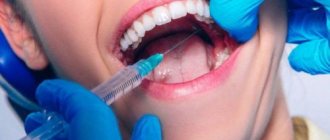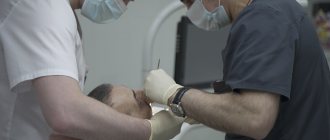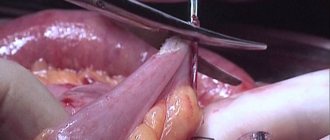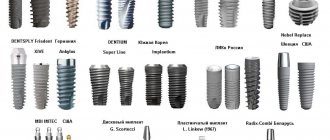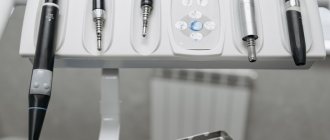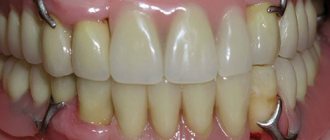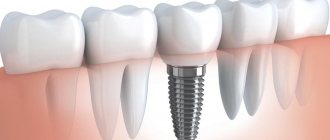When installing the implant, local anesthesia is used. Pain management helps reduce discomfort during the procedure. Dental implantation under anesthesia is carried out with the simultaneous introduction of several implants. This makes the intervention painless and psychologically comfortable for the patient.
Prices
| Service | Price |
| Installation of the Astra Tech implant (Sweden) | from 59,000 rub. |
| Installation of Bicon implant (USA) | from 45,000 rub. |
| Installation of MIS implant (Israel) | from 25,000 rub. |
| Installation of Osstem implant (South Korea) | from 19600 rub. |
| Installation of the SLA implant (Switzerland) | from 50,000 rub. |
| Installation of Super Line implant (South Korea) | from 35,000 rub. |
| Installation of the Nobel implant (USA) | from 59,000 rub. |
| Installation of Straumann implant (Switzerland) | from 45,000 rub. |
| Simultaneous installation of an Astra-Tech implant (Sweden) | from 55,000 rub. |
| Simultaneous installation of the Bicon implant (USA) | from 50,000 rub. |
| Simultaneous installation of the Nobel implant (USA) | from 55,000 rub. |
| Simultaneous installation of the Osstem implant (South Korea) | from 25,000 rub. |
| Installation of 4 Osstem implants (South Korea) | from 85,000 rub. |
| Installation of 6 Osstem implants (South Korea) | from 120,000 rub. |
Sign up for a consultation
In a dream or in reality - when sedation is appropriate
If local anesthesia does not work
Dental implantation is a painless procedure in the vast majority of cases. And it doesn’t matter what protocol is used, under local or extended anesthesia. However, there are known exceptions:
- Local anesthesia may not work on the patient or may cause allergic reactions. In this case, there are only two options: general anesthesia or sedation.
- Anesthesia has a limited duration - it lasts 3-4 hours without the possibility of prolongation. If the doctor, for example, did not have time to sew up the implant shaft, the patient will remember the day of the operation for the rest of his life, and the surgeon will finish “with a living.” This will hurt, based on true events. This also imposes a limitation on the scope of the operation in terms of the number of implants that can be installed at one time.
When there are direct indications for sedation
The reasons that led our patients to sleep treatment:
- The pain threshold is reduced or the pain is not completely blocked by local anesthesia
- An overwhelming feeling of fear before dental treatment (dental phobia, panic attacks)
- Hypertension, vegetative-vascular dystonia, stable angina
- It is physically difficult to keep your mouth open for more than 60 minutes
- Increased gag reflex
- Allergy to anesthetics
In these cases, the choice is small - in order to restore chewing function, the patient is simply forced to turn to sedation.
The patient's desire to experience the operation comfortably
What prompts our patients to “get their teeth done” under sedation if there are no direct indications? Of course, comfort.
Anyone who has installed an implant under local anesthesia at least once in their life will never forget these incomparable sensations. Moreover, the people who participated in this event share their memories with pleasure and in vivid colors with others, completely undermining the desire of friends, relatives and colleagues to get a “Hollywood smile.”
Implantation in a dream is an opportunity to avoid unpleasant sensations, worries and anxiety, and not to store unpleasant memories. The operation is comparable in sensations to a SPA procedure. The patient falls asleep without teeth and wakes up with implants when everything is over. The highest degree of comfort and serenity.
Main types of anesthesia for dental implantation
- General anesthesia or drug-induced sleep is anesthesia when a person is rendered unconscious for the period of the main work on installing implants.
- Local – anesthesia that covers the oral cavity and bone in the area where titanium roots are introduced during implantation.
Local anesthesia is:
- application anesthesia - anesthesia, when applications with an anesthetic are applied to the tissues of the oral cavity;
- conduction anesthesia - anesthesia in which an anesthetic is administered to the area closest to the nerve endings; as a rule, concentrated solutions of anesthetics are used, but without the use of a syringe;
- infiltration anesthesia - the so-called “freezing” anesthesia, when receptors are blocked directly in the injection zone.
- Sedation is anesthesia without suppressing the central nervous system, a person does not feel pain or fear, perception is slightly dulled, but at the same time fulfills the doctor’s requests. The person being operated on often does not remember the procedure for installing implants for moments, but does not resist.
Sedation happens:
- moderate sedation;
- deep sedation;
- minimal sedation.
Which anesthesia to choose for implantation? The doctor makes the decision based on the client’s general health, his age, possible diseases of the nervous system, heart and blood vessels, and previous types of anesthesia.
Implantation under sedation or general anesthesia: which is better?
| Disadvantages of anesthesia | Benefits of Sedation |
| Composition Sedative and toxic narcotic drugs, opiates | Composition Ultra-short-acting hypnotics without toxic impurities |
| Effect on the body Completely unconscious state. Respiratory depression, obstruction of the airway and obstruction, connection to a ventilator is required | Effect on the body Drowsiness, relaxation, calmness, slight euphoria. Preservation of swallowing and breathing reflexes, reactions to verbal stimuli |
| Duration No more than 3-4 hours in a row, prolongation is not practiced, because harms the body | Duration Up to 14 hours straight with the possibility of breaks for rest, visiting the restroom and even snacks |
| After treatment Clouded consciousness, nausea to vomiting, dizziness. Mandatory hospital stay for 1-2 days | After treatment Quick “exit” with a clear mind. Strong tea, and go home within 30-40 minutes after surgery |
Our Center does not use anesthesia - only sedation
We do not use narcotic substances in treatment and guarantee that sedation drugs do not have any effect on the body. These are modern ultra-short-acting sleeping pills. Propofol and diprivan have a diuretic effect and are eliminated from the body within an hour. It is impossible to detect traces of drugs after two hours; they are inactivated and excreted in the urine.
Levin Dmitry Valerievich Chief physician and founder of the Doctor Levin center
How is implantation performed in a dream?
At a consultation with an anesthesiologist-resuscitator, an anamnesis is collected. In most cases, no special preparation is required for sedation, unlike anesthesia. Only for older patients and with general somatic diseases, if necessary, you will need to undergo tests and obtain a cardiologist’s opinion.
On the day of surgery:
- Putting you to sleep A sedative is administered intravenously. Dosing, speed and frequency are controlled by an automatic infusion pump connected to a butterfly catheter on the patient's wrist.
- Implantation under the supervision of an anesthesiologist The implantologist checks sensitivity and begins the operation. The anesthesiologist continuously monitors the patient's condition: electrocardiography, oxygen and carbon dioxide balance, respiration, pulse and pressure.
- Awakening and control After completion of implantation, a control 3D CT image is taken. If necessary, you can rest in the rehabilitation ward. Usually 30-40 minutes are enough to recover.
- You can go home After checking your well-being by the anesthesiologist, you can go home. Particularly determined patients leave in their own transport, which would be absolutely impossible after implantation under anesthesia.
General anesthetic drugs
Sevoran
This drug has a pleasant odor, which is important when inhaling it. Moreover, it is completely safe in terms of allergic reactions. The effects of sevoran begin with the first inhalation. After completion of the operation, the patient returns to normal very quickly and does not feel much discomfort from the effects of anesthesia.
Sevoran can be used both for children and adults. It is also indicated for people suffering from epilepsy, cerebral palsy and heart disease.
Foran
This drug, in fact, is a cheaper analogue of Sevoran. At the same time, it has a soporific effect on the patient for longer, namely more than an hour and a half. The use of Foran is indicated when it is necessary to simultaneously perform several dental operations.
This drug has a significant drawback - a very unpleasant odor. Because of this, the patient initially has to be put to sleep with the help of Sevoran, and then Foran is used.
Xenon
This drug is an inert gas, tasteless and odorless. It is non-toxic and absolutely harmless. The advantages of the drug include the fact that under its influence, postoperative swelling and pain do not occur in the oral cavity. Xenon is quickly eliminated from the body, leaving no traces behind. In essence, this gas has no contraindications for use.
Safety of sedation
Unlike general anesthesia, sedation does not depress the body. General anesthesia with narcotic drugs is a highly toxic method of pain relief. It has a lot of complications, incl. breathing problems, panic attacks, tachycardia, memory loss. Moreover, they do not appear immediately, but after a month or two. It is not advisable to use this method in dentistry, only in the case of complex orthognathic operations or extensive bone tissue transplantation.
Sedation is safe, does not have a toxic effect, and the patient recovers comfortably from the condition. Used for various dental procedures - tooth extraction, root canal treatment, prosthetics, implantation, sinus lifting, bone grafting, ENT dentistry.
Sedation is the “gold standard” of comfortable dental treatment without pain, consequences and memories, which is followed in all developed countries of the world.
Our Center provides all measures for safe implantation during sleep:
- To put the patient into a medicated sleep, our Center’s specialists use only substances that do not pose a risk to human health. We never use narcotic drugs .
- We use only original ultra-short-acting sedatives Diprivan (France) without difficult recovery from sleep. A hospital stay is not required, which is a prerequisite after implantation under general anesthesia.
- The entire process is supervised by a licensed staff anesthesiologist . Monitors the patient's condition on a monitor that displays body readings.
- A defibrillator is always prepared in case of unforeseen situations. This is a prerequisite for performing operations under sedation or general anesthesia. Fortunately, in our Center the device has never been used during operations.
Possible complications and consequences of treatment
The use of general anesthesia can cause such consequences:
- Nausea. A common complication of general anesthesia.
- Sore throat, dry mouth. These manifestations can persist for up to two days.
- Shiver. Lasts no more than half an hour.
- Lightheadedness or dizziness. The reason for this effect is the decrease in blood pressure during medicated sleep.
- Itching. It is a side effect of a number of medications used during surgery. May indicate an allergic reaction.
- Confusion (more often in elderly patients).
- The patient may regain consciousness during implantation. This situation is rare and occurs due to the fault of the anesthesiologist (incorrect selection of the drug or dosage).
After implantation, regardless of the type of anesthesia, complications may occur:
- The appearance of pain after the end of anesthesia. The normal condition is considered to be soreness for 2-3 days; longer sensations may indicate the development of inflammation.
- Swelling of soft tissues. It is considered a normal reaction of the body to a foreign object (implant). It may occur within a few hours after surgery and persist for 5-7 days.
- Bleeding. Minor bleeding from the operated area may occur for no more than 10 days. Intense, prolonged bleeding is a symptom of damage to a blood vessel.
- Temperature increase. A normal reaction is considered to be a temperature not exceeding 37 degrees for 2-3 days. A prolonged increase in temperature and the formation of pus indicate an inflammatory process.
- Dehiscence of seams due to mechanical damage or inflammation.
- The development of an inflammatory process as a result of infection entering the space between the implant and the gum.
- Implant rejection. Under the influence of certain factors, the jaw bone does not accept a titanium rod. Signs of this are pain and mobility of the implant.
Our sleep implantation standards
Implantation under sedation involves the simultaneous work of a dentist-implantologist or maxillofacial surgeon and an anesthesiologist-resuscitator. Each specialist is responsible for his work. Therefore, we devote enough time to each patient. We provide personalized medical care without haste or fuss, and do not work on the fly. This allows us to minimize medical errors so that the patient only comes to the clinic for routine examinations.
Doctors
The installation of implants in our Center is carried out only by experienced implantologists and maxillofacial surgeons, trained in the nuances of working under sedation. These are thoughtful specialists with continuous practical work experience of at least 5 years and honed manual skills.
Under local anesthesia, the surgeon installs implants in the patient in a semi-vertical position, and when the patient is sedated or under anesthesia, he lies down, and a manually untrained doctor will make mistakes.
Our full-time anesthesiologist-resuscitator, who has been working at the Center since 2003, is responsible for safety during sedation. During all this time there was not a single case when “something went wrong.” We do not use the services of “specialists” who come for an hour, who will “evaporate” at the first problem.
Equipment
Preparations and materials
Diprivant (France)
We use only imported (France) original ultra-short-acting sleeping pills, without “severe” narcotic consequences.
Nobel Biocare implants
We work only with products from the world leader Nobel Biocare. We do not install alternative systems, because... have a limited warranty period.
Safe materials
We use biocompatible inorganic preparations, bone growth stimulators BMP. We do not use questionable methods for transplanting donor bone blocks.
In what cases is local anesthesia sufficient?
Local anesthesia, which is most often used during implantation, can be used during the installation of one to four implants, provided there is sufficient bone volume and there is no inflammation at the site of the extracted teeth. However, more and more often we additionally use intravenous sedation or general anesthesia, which allows a person to go through this exciting life moment comfortably and safely. The use of sedatives leads to the elimination of fear and anxiety during surgery; in addition, after dental treatment under sedation, quite often there are no memories of what happened in the operating room. When general anesthesia is used, memories are always absent. This “loss of memory” of unwanted events helps people not to aggravate their fear of dental procedures. Often, dental treatment under general anesthesia or sedation in combination with the work of a psychologist can help get rid of dental phobia.
In Europe, people with dental phobia have been receiving sedation for many years, while in Russia doctors sometimes do not pay enough attention to the psycho-emotional state of the patient. Unfortunately, horror stories about anesthesia are quite popular in our society, this largely reflects people's fear of something unknown and beyond their direct control. Modern techniques of general anesthesia and sedation make it possible to comfortably and safely carry out surgical treatment of any extent, even to the most anxious patients and children.
Operation duration
It is installed by the operating surgeon together with the anesthesiologist-resuscitator. Directly depends on the volume of bone tissue, the condition of soft tissues in the working field, the number of implants planned for installation on the day of surgery, and the need for tooth extraction. Approximate boundaries:
| Scope of work | Hours of sedation |
| 1 implant | 1 hour |
| 2-3 implants | 2 hours |
| 4-6 implants | 3-4 hours |
| 7-15 implants | 5-6 hours |
| 16-20 implants | 7-8 hours |
| Sinus lift in the area of 1-2 teeth | 1 hour |
| Guided bone regeneration in the area of 2-3 teeth | 2 hours |
| Removal of 1 tooth | 1 hour |
| Gum plastic surgery in the area of 1 segment | 1 hour |
After implantation
Anticipating the patient's condition and possible emotionality after the operation, we made sure that he was provided with all the necessary medications
After implantation, all our patients receive a package with postoperative recommendations and a set of medications that may be required during the recovery process. These are painkillers, antihistamines, antibiotics, antiseptics, etc.
For those who want to speed up the rehabilitation process, unique recovery methods have been developed. Aimed at eliminating tissue damage, restoring their integrity, suppressing inflammatory and destructive processes.
Skin bioreparation
Injections of hyaluronic acid enriched with vitamins, microelements, peptides and amino acids. Improves the condition, acts immediately.
Plasmolifting PRP
Administration of blood plasma to stimulate regeneration processes. Accelerates healing, prevents the appearance of hematomas, reduces swelling.
Microcurrent therapy
Improves blood circulation and accelerates cellular recovery. Eliminates swelling, relieves muscle microspasms and pain.
Contraindications
99% of our patients who require sleep implantation have successfully used the service. But every method has exceptions that impose restrictions
- Difficulty in nasal breathing and cough
- Acute circulatory disorders
- Severe traumatic brain injuries
- Severe mental disorders
- First trimester of pregnancy, breastfeeding
- Decompensated cardiovascular diseases
- Acute coronary syndrome, arrhythmia, cardiomyopathies
- Allergic reaction to certain components of the drug
- Bronchial asthma
- Epilepsy
What is premedication?
Local anesthesia during implantation is always sufficient to eliminate discomfort. But sometimes the patient is so worried and afraid of the operation that the doctor has to take additional measures to help the person calm down.
Premedication helps reduce excessive anxiety. This is a course of drugs with a sedative effect, which must be taken one or two days before the planned implantation. They relieve the patient of anxiety and fear of surgical procedures, and the doctor is able to work normally. Premedication may be indicated not only for people with increased sensitivity to psycho-emotional stress, but also for people with diseases of the cardiovascular system.
Life time
Our Center has been working exclusively with Nobel Biocare (USA) implantation systems since 2003
The company guarantees an indefinite service life of implants due to the maximum level of production control. According to the experience of our specialists, implants are included in the rejection statistics less often than all other implantation systems.
We are a Nobel Biocare Center of Clinical Excellence . This confirms that the failure rate of implants installed in our clinic over 10 years of operation does not exceed 2%.
Guarantees
A lifetime guarantee is provided for all surgical procedures without exception, incl. sinus lift and bone grafting
All specialists at our Center work in strict compliance with internal quality standards - from the patient’s first visit to annual preventive examinations. Therefore, we provide a lifetime guarantee not only for implants, but also for their installation in the LifeTime Warranty since 2003. Each patient receives a passport for installed implants.
Types and benefits of dental implants
In modern dental clinics, high-quality implants from world manufacturers are used to restore the aesthetics and functionality of the dentition. All designs are divided into several groups.
Types of dental implants: description
, indications for installation:
1. Root-shaped - the most popular dental implants are cylindrical in shape with threads. The main design is a titanium pin. The implant takes root quickly, the risks of postoperative complications are the lowest. Installed when there is sufficient bone tissue.
2. Plate implants have a porous plate with a pin. Can be used if the bone tissue is too thin, when installation of a root-like structure is considered impossible. They are not designed for heavy loads, so they are mainly used to restore front teeth.
3. If there is a lack of bone tissue, subperiosteal implants, implanted into the space between the bone and the gum, are also effectively used. Recommended for installation after long-term absence of teeth.
4. Mini-implants are the optimal design for installation in patients who are contraindicated for full dental implantation. Such implants are used in single quantities and are not suitable for restoring a whole series.
On the dental implant market, global manufacturers present a wide variety of designs for restoring lost teeth, each with its own characteristics, advantages and disadvantages. Before carrying out a surgical procedure to implant an artificial tooth, it is very important to choose a high-quality implant with good performance characteristics and rapid healing.
